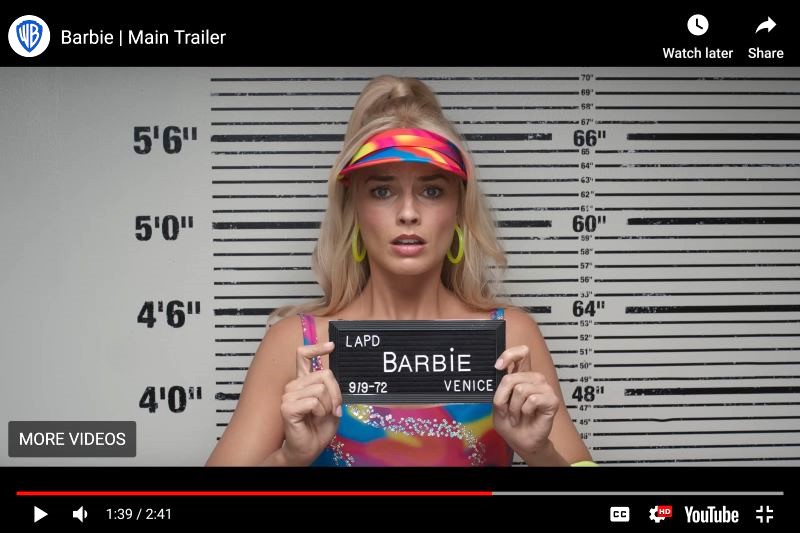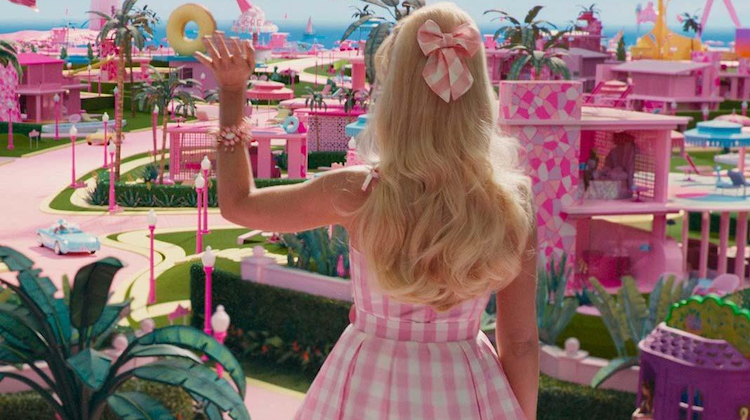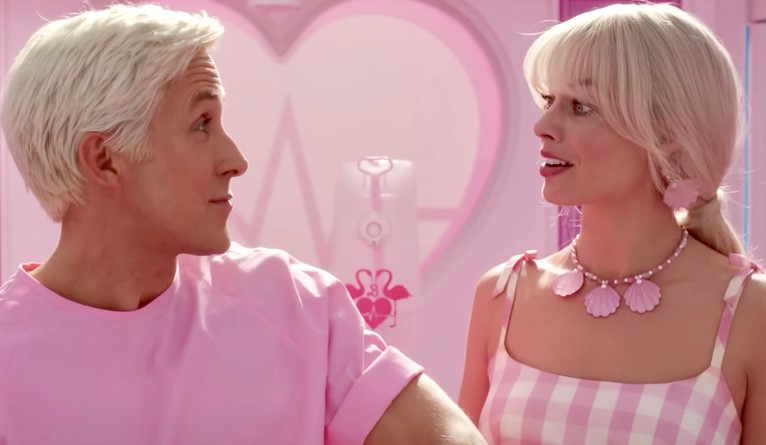“Barbie” walked a marketing tightrope with Job No. 1 being to satisfy the core girl audience of the toy line while at the same time pushing different messages to adult demographics.
To go wider, the breezy Ken character delivered dry humor, a police mug-shot photo of the Barbie character showed her being busted (Ken too), and other out-of-character self-parody was introduced in marketing. These aimed to snag the adults demographic.
The core girls’ audience, with oldsters piled on top, combined to make the movie adaptation of the iconic toy doll a $1 billion-plus boxoffice sensation. The Warner Bros. Pictures live-action film starring Margot Robbie passed the $1 billion global boxoffice mark just 17 days after its July 21 release. The PG-13-rated family film cost a reported $145 million to make — which is a somewhat above average for a major studio film budget but well below the very top-end cost.

The film adapts from the Mattel Toys beach-life-loving doll that launched in 1959 and today generates $3 billion annually in toy sales.
‘Barbie’ Case Study
The “Barbie” campaign first and foremost aims to satisfy the toy brand’s core girls audience. The brand’s signature pink color drenched the movie and its marketing messaging. Actress Margot Robbie is presented as glamorous, enthusiastic and fun-loving, which are true to the source Barbie doll. The PostTrak exit poll put the initial “Barbie” cinema audience at 68% female (versus females 50.5% of the population and usually under indexing in cinema).
Other strands of marketing (drawing from the movie itself) messaged that the “Barbie” movie isn’t just kids stuff. The key copy line on an early film trailer clearly stretches for a duality: “If you love Barbie, if you hate Barbie, then this movie is for you.”
In marketing to adults, an early trailer attached to “Avatar: The Way of Water” that is an unlikely companion as a serious fantasy film. And the “Barbie” trailer also employed music from and projected the feel of revered sci-fi film classic “2001: A Space Odyssey.” Those two associations signaled “Barbie” is not just a cutesy kids’ film (the reference to “2001” clearly went over the heads of the girl demo, but no harm).
The self-mocking humor includes comedian Will Ferrell cast as the humorously malevolent boss of Mattel in the movie. In shtick for adults, the Ferrell character nixes an equity initiative policy for Barbie Land, but abruptly reverses himself after being told it will be profitable. In another bid for adults, an online promotion with Snapchat allowed users to model on themselves a virtual Barbie wardrobe from the app’s Lens Carousel; that appeals to both the core girls’ audience as well as playful adults.
Ken — portrayed by Ryan Gosling — is the unlikely villain in “Barbie” and a hero of the marketing campaign. In the movie, he starts off as merely a love-sick accessory but then has an epiphany of masculinity and tries to take over Barbie Land.
The actor Gosling frequently pumped up adult humor in prerelease publicity. For example, Gosling told TV show “Entertainment Tonight” that “Ken’s got no money, he’s got no job, he’s got no car, he’s got no house. He’s going through some stuff.” That’s a laugh for adults and was probably not understood (and ignored) by the core girls’ demo.
Early publicity a year before the cinema premiere generated a burst of consumer buzz and press attention. The lead characters were pictured in August 2022 (11 months before theatrical premiere) roller skating in bright Barbie-esque color costumes along a sun-drenched California coastline. Usually, such a photo blast would be a few months in advance of theatrical premiere, because longer risks curious consumers will forget.
Such early Dayglow-colored publicity seems unnecessary because the toy property is well known and doesn’t need to build awareness. Going early with publicity for such a familiar property risked burning out consumers, but in “Barbie’s” case worked.
The audience was surprised, delighted and favorably engaged, in a tribute to Warner Bros. Pictures marketing. Engaging content for professional press and consumers in social media was dribbled out early, but not too much that risked audience burnout. A little went a long way!

The underlying toy property is a movie marketer’s gold. Audiences and any prerelease business meetings for the movie certainly are loaded with adults who played with and/or have warm feelings today about the surfer girl toy property.
One can imagine real-life meetings for an automobile tie-in. The Barbie toy line is famous for her driving her pink Chevrolet Corvette, circa late 1950s (not a modern Corvette). So, who got the movie tie-in? Chevrolet again for the Chevy Blazer EV SS, which the General Motors brand that used “Barbie” to promote its electric vehicle model. Besides the classic-model pink Corvette, the movie shows on screen a contemporary General Motors’ GMC Hummer EV.
Indeed, the movie reportedly attracted 100 promotional partners: These include Airbnb (for real-life rental of the pop-up the Malibu Barbie Dreamhouse that generated press coverage), Crocs shoes, fashion retailer Forever 21, home decorating HGTV cable TV network, video streamer Roku, Prada luxury and Progressive insurance. Some of the promotional partners have pre-existing connections to the doll property via Mattel.
“All told, these partnerships are worth at least $70 million to Warner Bros. and toymaker Mattel, home of Barbie,” says a Hollywood Reporter story by Pamela McClintock. “And the value of the publicity the film has generated is immeasurable, from local TV news spot to features in Architectural Digest and The New Yorker. Stories about ‘Barbie’ have become ubiquitous. … Pink is the new green.”
As for licensed merchandise, it’s a long list including matching Barbie and Ken in-line skating apparel; doll-size Ken faux fur coat and black fringe vest; toy Hot Wheels Barbie Corvette 4-Pack; Funboat’s inflatable plastic pool float boat in pink; various toys such as the Barbie playhouse; and dolls galore.
Amazingly, the “Barbie” movie rights languished in Hollywood’s “development hell” since 2009 — optioned by studios first at Universal Pictures and then Sony Pictures — going nowhere. Then, the film rights moved to Warner Bros., which finally green-lit.
Those earlier efforts struggled presenting Barbie with modern sensibilities or, alternatively, portraying a traditional Barbie as an eccentric throwback. The Warner version hewed to the traditional Barbie personality with few apologies, and making the character an unlikely, clutzy girl-power superhero. But the movie itself makes few annoying bows to modern mores.
Ken is suddenly energized by becoming oafishly patriarchal with a male-domination outlook. This modern social dig probably goes over the heads of the girls’ demo, so (again) harmless.

It’ll be interesting to see if Warner Bros. feels compelled to inject more modern social commentary in any sequels. No sequel is known to be in the works yet as Hollywood is on lockdown because of a writers strike. Mattel has 14 other live-action movies in development including adaptations of its Hot Wheels, game card Uno and purple dinosaur Barney product lines.
Though the “Barbie” movie is a stupendous financial success, it remains to be seen how lasting the rub-off will be for Mattel’s toy products. Early signs are a big lift but of short duration, because the social preaching in the movie has triggered a mild backlash in consumer buzz.
Since Warner Bros. financed the movie, Mattel’s benefit is a fixed percentage royalty plus for licensing its intellectual property and plus any lift the movie gives for sales of Mattel’s products. An analyst expects Warner Bros. to ultimately pay between $25 million-$50 million in “Barbie” movie royalties.
Finally, for anyone who wants to dispute “Barbie” contained woke barbs, argue with liberal commentator Bill Maher, who lamented: “OK, ‘Barbie’: I was hoping it wouldn’t be preachy, man-hating, and a #ZombieLie — alas, it was all three.” He defines a zombie lie as something that isn’t true or was true in the past but isn’t any more.
Related content:

Leave a Reply